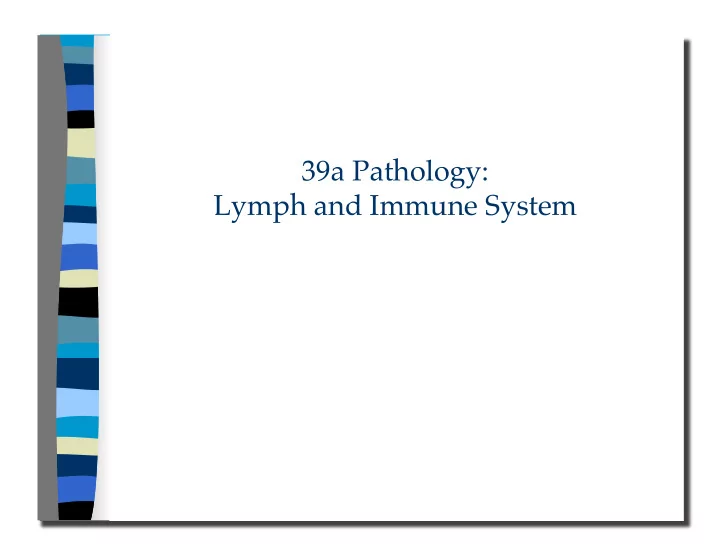

39a Pathology: � Lymph and Immune System
39a Pathology: Lymph and Immune System � Class Outline � 5 minutes � � Attendance, Breath of Arrival, and Reminders � 10 minutes � Lecture: � 25 minutes � Lecture: � 15 minutes � Active study skills: � 60 minutes � Total �
� 39a Pathology: Lymph and Immune System Class Reminders � Assignments: � 41a Review Questions (A: 149-162) � � 43a Swedish: Outside Massages � � Quizzes: � 42a Written Exam Prep Quiz (35a, 36a, 37a, 38a, 39a, 40a, and 41a) � � 42b Kinesiology Quiz � � – adductor magnus, gracilis, iliopsoas, sartorius, TFL, piriformis, quadratus femoris � 44a Written Exam Prep Quiz (33b, 37b, 41b, 42b, and 43a) � � Practical Exam: � 44b Integration Massage: Practical Exam (60-minute Swedish, Passive Stretches, and BMTs) � � Preparation for upcoming classes: � 40a A&P: Reproductive System � � – Trail Guide: piriformis and quadratus femoris � – Salvo: Chapter 25 � – Packet E: 81-84 � – Packet A-158 � 40b BMTs: Guided Full Body � � – Packet F: 85-86 �
Classroom Rules � Punctuality - everybody’s time is precious � Be ready to learn at the start of class; we’ll have you out of here on time � � Tardiness: arriving late, returning late after breaks, leaving during class, leaving � early � The following are not allowed: � Bare feet � � Side talking � � Lying down � � Inappropriate clothing � � Food or drink except water � � Phones that are visible in the classroom, bathrooms, or internship � � You will receive one verbal warning, then you’ll have to leave the room. �
39a Pathology: Lymph and Immune System � Packet E-77
Lymph System Disorders
Lymph System Disorders Edema Accumulation of excessive fluid between cells. May be local or systemic problem, and is usually associated with chemical imbalance, inflammation, or poor circulation. �
Lymph System Disorders Edema Accumulation of excessive fluid between cells. May be local or systemic problem, and is usually associated with chemical imbalance, inflammation, or poor circulation. � Pitting edema �
Lymph System Disorders Lymphangitis Infection with inflammation in lymph capillaries, usually arising from a small injury on the skin. �
Lymph System Disorders Lymphadenitis Infection of lymph nodes. Should bacteria get past the filtering action of the nodes, septicemia (blood poisoning), a potentially life- threatening situation, has occurred. �
Lymph System Disorders Lymphoma A collective name for cancer that starts in lymph tissues. Mutated lymphocytes replicate in massive numbers, causing enlargement of lymph tissues, anemia, night sweats, itchy skin, and fatigue. �
Lymph System Disorders Hodgkin lymphoma B cells mutate into large, malignant cells. These growths eventually metastasize to organ tissues. �
Lymph System Disorders Mononucleosis Viral infection of salivary glands, throat, and lymph nodes. Eventually infects B-lymphocytes, which carry it on to lymph nodes, liver, and spleen. Mainly depletes stamina, resiliency, and strength. Seldom but occasionally has serious complications. �
Immune System Conditions
Immune System Conditions Allergic reactions Immune system reactions to stimuli which are not inherently hazardous. Usually involve inflammation, and may range from mild to life-threatening. �
Immune System Conditions Chronic fatigue syndrome Collection of signs and symptoms that affect multiple body systems and result in mildly limiting to debilitating fatigue. These may include tender lymph nodes, low-grade fever, sore throat, headache, muscle/joint pain, sleep or memory problems. �
Immune System Conditions Fever (AKA: pyrexia) Abnormally high ( >101°F) body temperature. May include shivering, flushing, and sweating. Usually caused by bacterial or viral infection. �
Immune System Conditions HIV Human immunodeficiency virus. Causes AIDS. � AIDS Acquired immune deficiency syndrome. Disables the immune system leaving a person vulnerable to a host of diseases that are usually not a threat. �
Autoimmune Disorders
Autoimmune Disorders � Ankylosing spondylitis Progressive inflammatory arthritis of the spine, leading to stiff joints. Typically begins at sacro-iliac joints, and may progress up the spine and/or affect costovertebral joints, and thus, breathing.
Autoimmune Disorders � Crohn disease Progressive inflammatory disorder affecting the G.I. tract, characterized by deep ulcers, scarring, and formation of fistulas around small and large intestine. Involves abdominal pain, cramping and diarrhea. �
Autoimmune Disorders � Inflammatory bowel syndrome Crohn disease and ulcerative colitis. �
Autoimmune Disorders � Lupus Antibodies attack various tissues (skin, heart, lungs, joints, kidneys). Ranges from mild to life-threatening. Women are 9 times more likely than men to be diagnosed with lupus. �
Autoimmune Disorders � Multiple sclerosis T cells, B cells, antibodies, and cytokines destroy myelin sheaths in the spinal cord and brain. May result in loss of motor control, cognitive changes, or motor and sensory paralysis. �
Autoimmune Disorders � Psoriasis Non-contagious chronic skin condition involving excessive production of skin cells. These result in itchy, scaly plaques on the skin, usually on trunk, elbows and knees. Runs in cycles of flare and remission. �
Autoimmune Disorders � Rheumatoid arthritis Synovial membranes of various joints are attacked by immune system cells. Other structures (muscles, tendons, skin, blood vessels and serous membranes) may also be affected. �
Autoimmune Disorders � Scleroderma Abnormal accumulations of collagen in the skin, blood vessels, and other tissues. Usually involves the hands and face. �
Autoimmune Disorders � Ulcerative colitis Inflammation and shallow ulcers in the colon. Symptoms similar to Crohn disease, but only the colon is affected. �
39a Pathology: � Lymph and Immune System
Recommend
More recommend